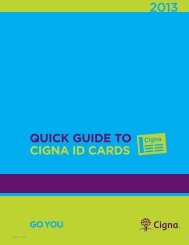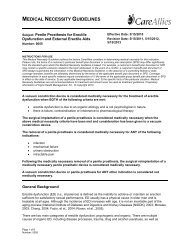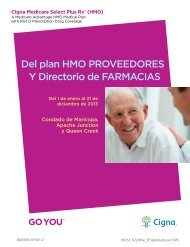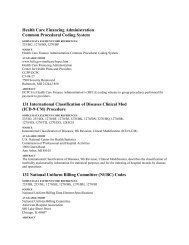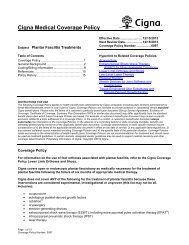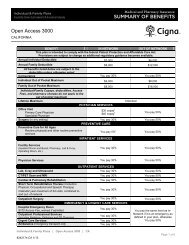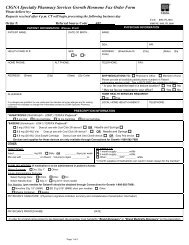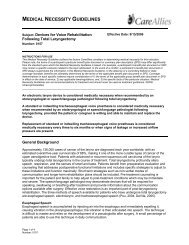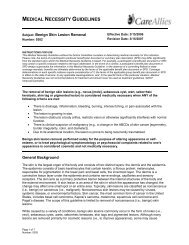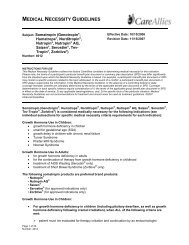Electrical Stimulators - Cigna
Electrical Stimulators - Cigna
Electrical Stimulators - Cigna
You also want an ePaper? Increase the reach of your titles
YUMPU automatically turns print PDFs into web optimized ePapers that Google loves.
Neck Pain: Following a systematic review of the literature regarding electrotherapy, including TENS, for neck<br />
pain, Kroeling et al. (2009) concluded that no definitive statements could be made regarding the efficacy and<br />
clinical usefulness of these modalities. Eleven TENS trials (n=7-30) met inclusion criteria including: TENS<br />
compared to placebo or another modality (i.e., ultrasound, manual therapy, electrical muscle stimulation); TENS<br />
plus another therapy (i.e., hot packs, infrared, exercises, neck collar and/or analgesic) compared to the other<br />
therapy alone; or different TENS regimens. The authors concluded that “very low quality” evidence showed that<br />
TENS might relieve pain better than placebo or electrical muscle stimulation but not as well as exercise and<br />
infrared and possibly as well as manual therapy and ultrasound.<br />
Osteoarthritis of the Knee: Rutjes et al. (2009) conducted a systematic review of the literature to evaluate<br />
transcutaneous electrical nerve stimulation for the treatment of osteoarthritis of the knee. Thirteen randomized<br />
and quasi-randomized trials (n=465) using TENS met inclusion criteria. Due to the heterogeneity of the studies<br />
and poor methodology, the authors could not confirm the effectiveness of TENS for this condition.<br />
Phantom Pain and Stump Pain: Mulvey et al. (2010) conducted a systematic review of randomized controlled<br />
trials to assess the effectiveness of TENS for the treatment of phantom pain and stump pain following<br />
amputation in adults. No studies were identified.<br />
Rheumatoid Arthritis: In a systematic review of the literature, Brosseau et al. (2003) evaluated the<br />
effectiveness of TENS for the treatment of rheumatoid arthritis of the hand. Three randomized controlled trials<br />
(n=78) met inclusion criteria. Conventional TENS (c-TENS) and acupuncture-TENS (acu-TENS) were compared<br />
to either placebo or each other. Results were conflicting on the effect of TENS on pain outcomes. Acu-TENS<br />
was beneficial for reducing pain intensity and improving muscle power scores compared to placebo. No clinical<br />
benefit on pain was reported with C-TENS compared to placebo. C-TENS resulted in a clinical benefit on the<br />
patients’ assessment of change compared to acu-TENS. The authors concluded that more well designed<br />
studies with a standardized protocol and adequate number of subjects were needed to fully identify the effect of<br />
TENS for the treatment of RA of the hand.<br />
Stroke: NG and Hui-Chan (2009) conducted a randomized controlled trial (n=109) to determine if TENS would<br />
improve functional walking performance (i.e., gait velocity, walking endurance and functional mobility) in<br />
hemiparetic stroke patients with spastic plantar flexors. In addition to a control group (n=29), patients were<br />
assigned to one of three intervention groups: TENS only (n=28), TENS plus exercise (n=27) or placebo<br />
stimulation plus exercise (n=25). Each patient self-administered 20 sessions, five days per week for four weeks.<br />
Each group received 60 minutes of TENS and the exercise groups received an additional 60 minutes of exercise<br />
following TENS or placebo stimulation. Final follow-up occurred four weeks after the treatment ended. At the<br />
final follow-up compared to all other groups, significant improvements were seen in the TENS plus exercise<br />
group in gait velocity (p



